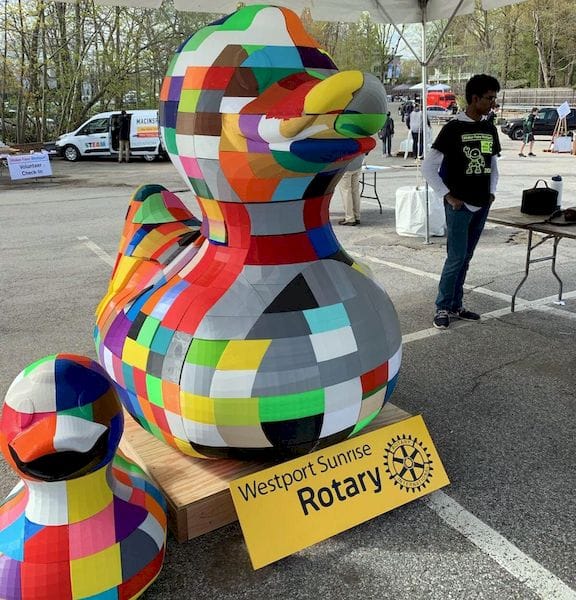![The Great Duck Project [Source: Reddit]](https://fabbaloo.com/wp-content/uploads/2020/05/image-asset_img_5eb09817a4514.jpg)
This week’s selection is The Great Duck Project.
What might be the world’s largest 3D printed duck — at least so far in human history — was produced by a crowdsourced project in Westport, CT. It was inspired by an annual race sponsored by the Westport Sunrise Rotary Club, in which rubber ducks are “raced” down a river. Members purchase raffle tickets in an attempt to predict the winner, as its a fundraising activity for this Rotary Club.
But it turns out members of this Rotary Club happen to also be 3D printing enthusiasts, and they set upon a rather ambitious project: to 3D print the world’s largest duck. They explain how the project came about:
“Mark Mathias is the founder and co-chair of Maker Faire Westport, Connecticut’s largest creativity and innovation event. He’s also a member of the Westport Sunrise Rotary club which has an annual event called The Great Duck Race. The Great Duck Race is a fundraiser for the club where 3,000 small rubber ducks are released into the Saugatuck River. The first 10 ducks to cross the finish line win a prize.
Whitney Kreuger presented an idea to the Westport Sunrise Rotary Club about a public art project using ducks. That inspired Mark to come up with a way Maker Faire Westport and The Great Duck Race could work together in a big way.
The idea was to create the world’s largest globally crowdsourced 3D printed duck. Mark met Jesse Robinson and Nicholas Iacobelli of Greens Farms Academy in Westport, Connecticut. Jesse and Nicholas offered to handle the logistics of creating the duck and so a partnership was formed.”
They offered an opportunity for the public to sign up and contribute a piece of the duck as assigned to them. This is quite similar to a project we reported on five years ago, where a group produce 3D printed pieces for a bust of George Washington, which they called, “George Crowdsourcington”.
In The Great Duck Project, however, a much larger statue was in the plans. In all, the duck was comprised of 476 3D printed parts, which were assembled by a crew and displayed at the Westport Makerfaire. The object is said to weigh around 200kg, so it might also be one of the heaviest thermoplastic 3D prints ever accomplished as well.
As you can tell from the images, the duck is composed of differently-colored parts. This is because the organizers could not hope that participants could guarantee the same colors — it’s hard enough to get a consistent color from the same filament manufacturer, let alone hundreds of random 3D printer operators!
Those joining the project were sent a 3D model file that they were assigned to 3D print. Participants were told they could submit assigned parts in any “rigid 3D printing material, which includes ABS, PLA, PETG, etc. Thus the duck is a mish-mash of different materials. But since its purpose is visual, it really doesn’t matter what it’s made from.
![Boxes of 3D printed parts for the Great Duck Project [Source: Reddit]](https://fabbaloo.com/wp-content/uploads/2020/05/3d-printed-duck-parts_result_img_5eb09817e8cf7.jpg)
Aside from the obvious demonstration of the power of parallel 3D printing, which enabled the rapid construction of this huge waterfowl, there’s another aspect that I wondered about: part tracking.
Imagine you are in charge of this project, and parts start arriving. Hundreds of them. Is there an easy way to keep track of them? How can you find a specific piece that’s required next for the build? These are actually serious issues that must have been resolved by the organizers in some way. One way is to embed a part number on the surface of each 3D model, which then ensures you cannot get too confused. And this is what these organizers did: each part had a specific number assigned to help keep track and ease counting and assembly.
Via The Great Duck Project and Reddit











This week’s selection is a 3D printed Coronavirus!